Twist of Fate
Welcome to Fated Week. This week, we are going to be talking about Fate and the Fated cycle from Born of the Gods. I'll be honest, I wasn't quite sure what to write about when I sat down to make this column. The Fated cycle doesn't exactly have the most elaborate design story. In fact, the design team didn't even make it. Tom LaPille had his team make it during development, so there wasn't a lot of story to tell. But then, something hit me.
You see, I like to consider myself a historian of the game; that history is not just about the elements around the game, but also the game itself. When I look at the Fated cycle I see a rich history of card design. So today, I thought what I would do is take this cycle and show all the elements of design that led up to it being made. In many ways, this is a history column, but instead of talking about people, I am going to talk about design. Good thing this is the design column.
- Your Fate Is Sealed
Let's begin by showing off the Fated cycle so everyone knows what inspired the history lesson of today's column. Here are the five Fated cards from Born of the Gods:
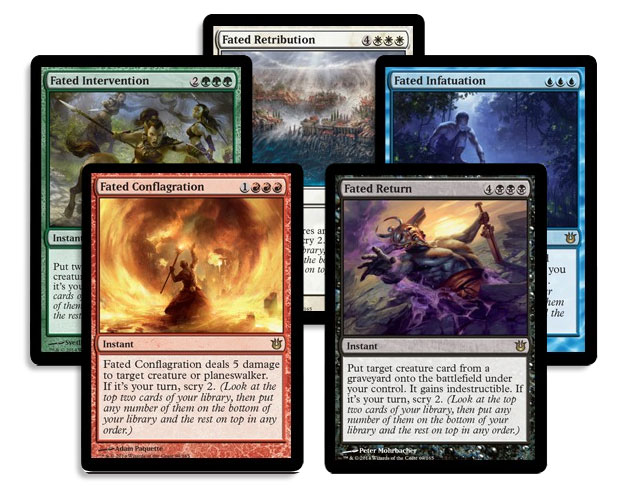
- Fast amp; Slow
Let's begin with the heart of the design. These five cards allow you to make a choice. You can cast these spells as a surprise on your opponent's turn or with less surprise on your own turn. If you choose to do it on your own turn, you get a bonus of getting to scry 2.
The core of this design stems from the fact that, strategically, you most often want to cast your instants on your opponent's turn, and usually at the very end. The reason for this is that it's the time where you have the least vulnerability. Your turn is just about to begin, so you'll be able to quickly get your lands untapped and not be vulnerable. In addition, playing instants on your opponent's turn allows you to get to react to what your opponent does. When you play spells on your turn, you give up the ability to surprise your opponent, often for tactical gain. One of the big early moments in playing Magic is making this realization about when it is most efficient to cast your instants or use your activated abilities.
The cycle of cards that first took advantage of this tension appeared in the set Mirage:
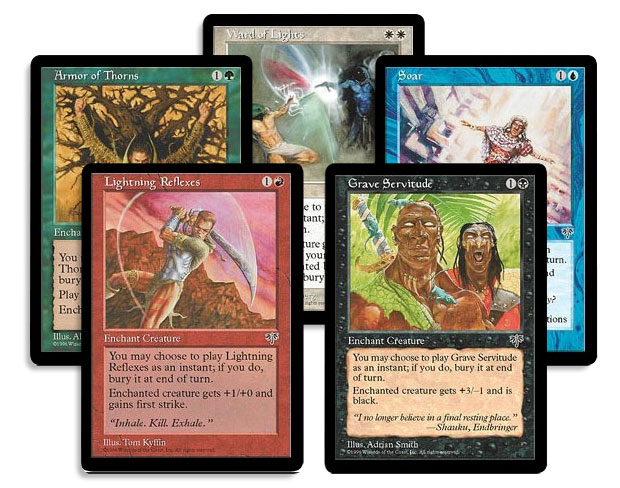
These five cards were all common Auras that had the text "You may choose to play CARDNAME as an instant; if you do bury it at end of turn." In modern templating it now reads "You may cast CARDNAME as though it had flash. If you cast it any time a sorcery couldn't have been cast, the controller of the permanent it becomes sacrifices it at the beginning of the next cleanup step." The idea behind this cycle was that you could cast the spell normally as an Aura or you could opt instead to essentially cast it as an instant whose effect only lasted until the end of the turn.
Much like the Fated cards, this cycle was making a similar offer. You can do this effect any time, but if you do it on your turn (although at the time an Aura could be cast), you get a bonus, which was that the effect stayed around permanently. It's important to note this first version did a bunch of things we have since learned not to do.
First, we now tend to make cards that reward you for doing something the less-efficient way rather than punish you for doing it the more-efficient way. Second, we are cleaner about the cards' card type. For instance, if you cast one of the Mirage Auras as an instant, was it actually an instant? Could it be countered by a spell that countered an instant? It was murky. Third, we tend to be more consistent with how our cycles work. For example, Armor of Thorns could not be cast on a black creature. It is the only Aura that comes with a casting restriction. (My guess, by the way, was this was done for a developmental reason—but it only goes to show how much our development technology has changed as well.) Also, all the cards in the cycle cost two mana but four of them cost 1C (one generic mana and one colored mana) while Ward of Lights cost WW. I've talked before about the 4/1 rule. If four cards in a cycle do something and the fifth does something different, it breaks the aesthetics and tends to upset the audience. For that reason, when we need to break things we tend to do 3/2 or 2/2/1 or have all five be different. Finally, if I want to be nitpicky, all of the Auras boost power and/or toughness except Ward of Lights.
The Aura cycle showed up in Limited and got a little bit of attention. It would later influence another cycle in the set Invasion (the Mirage cycle would also later inspire Auras with flash, but that's a different design fork).
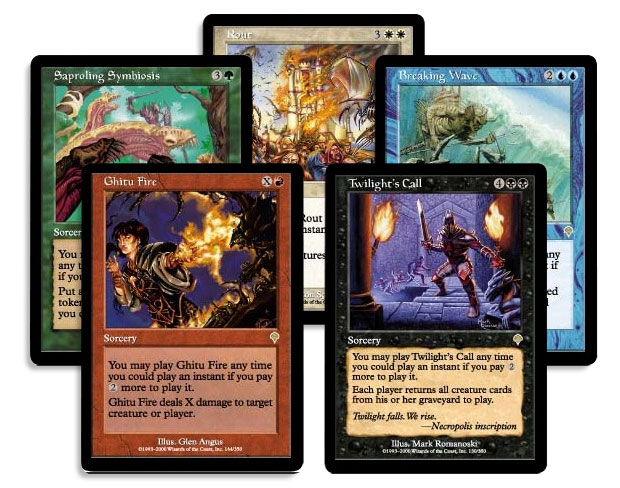
This rare cycle was all sorceries that had the added ability that you could pay an extra  to be able to cast them at any time an instant could be cast. Note that this didn't change them into instants (Getting the rules to pull this off would be complicated.) but rather allowed them to be cast when an instant could normally be played.
to be able to cast them at any time an instant could be cast. Note that this didn't change them into instants (Getting the rules to pull this off would be complicated.) but rather allowed them to be cast when an instant could normally be played.
Instead of punishing you for playing these as "instants," this cycle chose to require an additional cost. This is better than the Mirage cycle, but doesn't do much to encourage you to play them on your turn, especially if you have the mana. In addition, we broke up the mana cost 3/2 so three of them have two colored mana in their cost and two have only one. Looking the cards over, I'm pretty sure Ghitu Fire was the culprit that kept all of them from having two colored mana in their cost.
A few cards from this cycle saw some tournament play and it was definitely a higher-profile cycle. This was helped by the fact that it was a rare cycle that allowed the effects to be larger. Also, not being Auras was beneficial.
My biggest gripe with this design is that it didn't really present much of an interesting choice. Every once in a while you cast it on your turn because you don't have the mana or you need to save it for another spell, but most of the time, once you have the mana, you tend to treat it like an instant. This cycle would go on to inspire a cycle in Time Spiral:
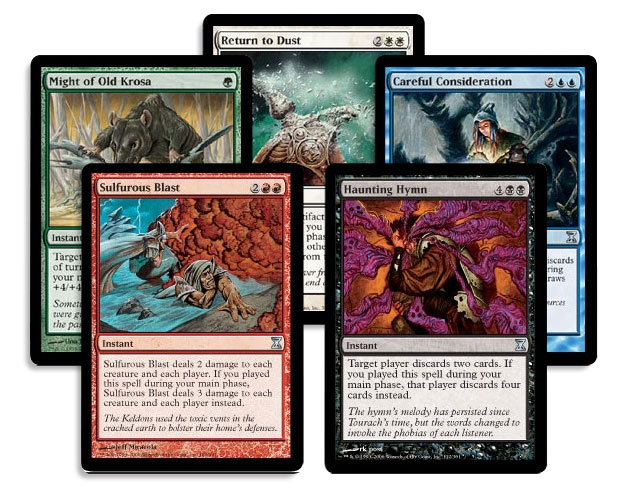
This was an uncommon cycle of instants from Time Spiral block. Each spell does something, but the effect gets larger if you cast it during your main phase. This is the first cycle in this design chain to reward the "slow" play rather than punish or require extra resources for the "fast" play. The one antiquity of this design is that it rewards you not for playing the spell on your turn but rather for playing it at the time sorceries could be played. This was our workaround to make the one version more sorcery-like.
The purist in me also notices the mana costs where four of the five cost double mana. Might of Old Krosa breaks the cycle because, obviously, at a mana cost of one, it can't have two colored mana. If we were doing this cycle nowadays, odds are we'd make one of the other spells not cost double colored mana. (Note that this is something design would do. Development often will ignore the aesthetics if the cards are aimed at Constructed and the costs have to be exact.)
One aspect I haven't talked about yet is that these designs require that the cards have a value both during your turn and during your opponent's. In order for the choice to be interesting, the effects have to be something where the value of them being an "instant" can offset the loss of the bonus. This is a lot harder to do than it might seem at first blush.
So this brings us back to the Fated spells from Born of the Gods. This cycle makes a few improvements over the Time Spiral cycle.
First, it changes it from main phase/not main phase to opponent's turn/your turn. This is a little easier to understand, as the Time Spiral version introduces vocabulary, "main phase," that beginners might not know. It also gives a little more flexibility, allowing the spells still to be cast at times only instants can be cast just only during your turn.
Second, the reward for the "slow play" is all lined up. That's important because it makes it easier to remember what the cards do.
Third, the mana costs are all lined up so they each require three colored mana. (Three colored mana was something development did to allow them to push the power level a little more, as the spells can only go in decks heavily dedicated to the color in question.)
- Scry
The lengthier version is here, but I'll give a short synopsis of scry's design. The Fifth Dawn design team was myself, Randy Buehler, Greg Marques (who would later work for Wizards but at the time did not—you can read that story here ), and Aaron Forsythe. At the time, Aaron ran the Magic website and had been brought on the team because we thought it would make for a good series of articles. Aaron quickly proved himself invaluable and was brought onto the Ramp;D Magic team, where he would flourish. Of the many accomplishments Aaron had on the Fifth Dawn team, the most impressive was probably the design of scry.
I had asked the team for a spell-based mechanic and Aaron sent in ten suggestions. Here was number 7:
7. Flow
Flow Growth
1G
Instant
Target creature gets +3/+3 until end of turn.
Flow (As part of this spell's resolution, look at the top three cards of your library, then remove any number of them from the game and put the rest back on top of your library in any order.)
This one is pure Spike, and to Spike these cards are golden. I like the way this would play. This is a "pure playability" mechanic, with no real flavor attached to it.
I originally turned "flow" down but Aaron convinced me that we should at least playtest it. I said okay but told him we had to change the name. I changed it to scrye (with the "e" like the Magic magazine from way back) to better match the flavor of using magical powers to learn about the future. Aaron was correct that the mechanic played well and it was added to Fifth Dawn.
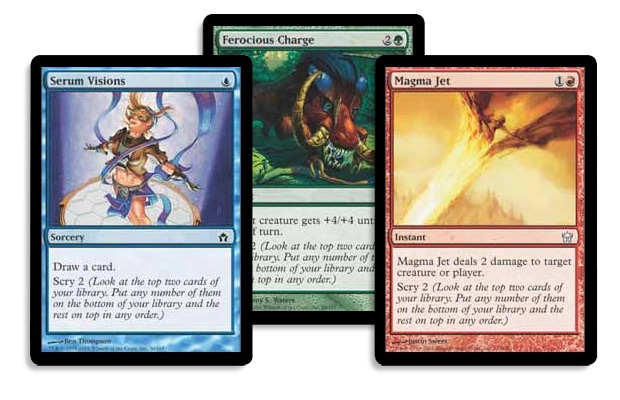
Nine cards had scry in Fifth Dawn. All of them used scry 2, but we chose to write it out because it was clear that there was potential for different scry numbers in the future. With one exception (Eyes of the Watcher, which was an enchantment that allowed you to pay  to scry 2 whenever you played an instant or sorcery), all of the cards in the set were instants or sorceries and the scrying was always a rider on a basic effect.
to scry 2 whenever you played an instant or sorcery), all of the cards in the set were instants or sorceries and the scrying was always a rider on a basic effect.
Three years later, while leading the design for Future Sight, I made use of scry for a second time.
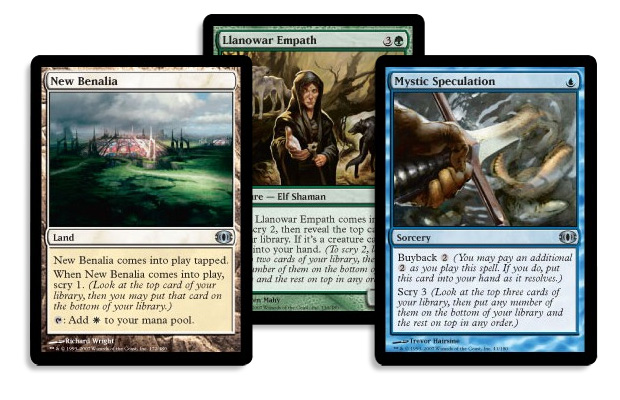
The Time Spiral block had a time theme, with the three sets representing the past, present (okay, alternative-reality present), and future. For each set, I wanted to bring back a mechanic that played into that set's theme. As Future Sight was about the future, scry, the mechanic where you peer into the future, felt like a perfect fit).
Future Sight played around a little more with what scry could do, making another nine cards. Cards would scry first and then make use of the card drawn, scry would be mixed and matched with other mechanics, it was used as part of cycles plucking mechanics from all over Magic's past, and it even made use of (gasp) scrying for numbers other than 2.
Another three years later, scry was brought back yet again in Magic 2011.
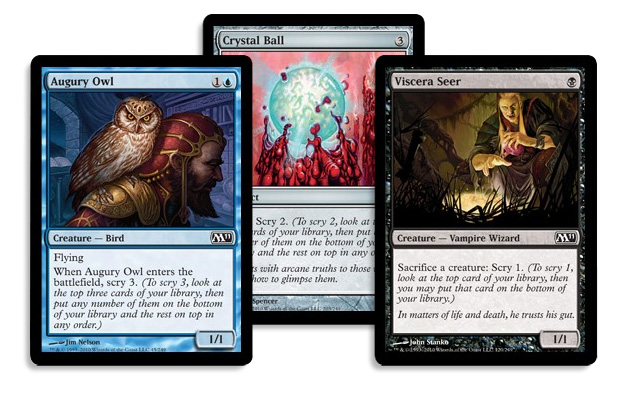
Magic 2010 had redefined what the core set was by including new cards for the first time ever. Magic 2011 was trying to find its identity when the lead developer, Erik Lauer, decided what he needed was to bring back scry to make a few new cards (four of the five scry cards in the set were new). Scry being in the set would set a precedent for each core set bringing back a non-evergreen mechanic. Erik selected scry for two basic reasons. One, it did good work of helping increase card flow and, two, it allowed him to make some very resonant, top-down designs—Crystal Ball being the highest profile of them.
Erik would be the one to bring it back yet again another three years later while developing Theros.
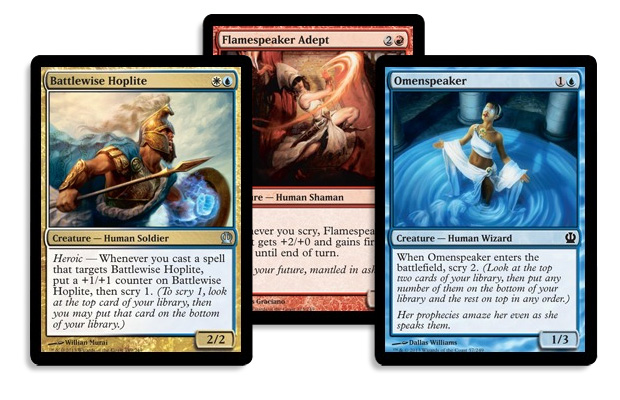
Erik was trying to find a way to increase card flow once again, as many of the mechanics in Theros required getting the right combination of cards together. Scry was a perfect fit not only for the set's mechanical needs but also perfectly matched the Greek mythology–inspired flavor.
Which brings us back to the Fated cards. Born of the Gods had been handed off from design to development. Tom LaPille, the lead developer of Born, felt that the set had a lot of fun Timmy and Johnny cards but was a little light for Spike, so he and his development team set out to make a rare cycle with Spike in mind.
Tom and his team explored previous rare Spike-friendly cycles. One of the cycles they looked at was the rare "sorceries that could be upgraded into instants" spells from Invasion (see Rout and buddies above). Tom liked the idea that the cycle would be spells that gave the player an option when to play them and that the less flexible option would come with a bonus. Scry was already in the set and was a very friendly Spike mechanic, so Tom decided to that it would be a good choice as the added value for the spells. And, thus, the Fated cards were born.
- A Linked Cycle
The last element of this cycle is something I don't think players think too much about, but it's something the designers and developers and the creative team are very conscious of. Once a cycle is added to a set, there is one more important thing that has to be done. The cycle has to be connected. What do I mean by that? Part of making something to draw attention includes making sure players notice it.
One of the things you learn while working in Ramp;D is that the things we take weeks and months and sometimes years stressing over are not always so obvious. Because of that, we have learned the importance of linking. Linking is making sure some element of a cycle is the same so players can notice it's a cycle.
There are numerous ways to link a cycle. Here are the most obvious:
Name: This is one of the strongest ways to get players to connect a cycle of cards—make the names connect in some way. The most common way to do this (and it's how the Fated cards do it) is to have the same word or words in all the titles. The names can also have a similar structure, but that can be easier for players to miss. An example of this would be the alternative-win cycle from Odyssey block—Test of Endurance, Battle of Wits, Mortal Combat, Chance Encounter, and Epic Struggle. Each title has a synonym for "conflict."
Mana Cost: The way you link mana costs is usually to have costs that are the same, with the exception of colored mana. Sometimes, as with the case of the Fated cards, the connection is not the total mana cost but a portion of it. The Fated cards, for instance, all have exactly three colored mana in their mana cost. In general, mana cost is one of the subtler links.
Art/Artist: Probably the highest-profile component of the card is the art. There are a number of ways to use the art to tie a cycle together. The card concept illustrated in the art can be similar. The composition of the art can be paralleled. The same artist can be used. Sometimes multiple of these can be done together.
Card Type or Subtype: The key to this connection is to have all the cards share a type or subtype. Usually, it will be something rather unique. The gods' weapons from Theros, for example, were all legendary enchantment artifacts, the first time that mix of card types had ever appeared. It is also very common for cycles to share a single card type. The Fated cards, for instance, are all instants.
Rarity: Having the entire cycle existing at the same rarity is subtle but can be another similarity.
Keyword/Ability Word: Another common connector is a keyword or ability word shared by all the cards in the cycle. The Fated cards, as an example, all have scry 2.
Templating: Another way to connect the cycle, also in the text box, is to use parallel templating. For instance, all the Fated cards have "If it's your turn."
Power/Toughness: If the cycle is made up of creatures, sometimes the power and toughness will all be the same. If the combination is not unique, this usually isn't noticeable unless there are other similar qualities.
Now let's do an inventory on the Fated cycle. They all share a word in their name (Fated), a similarity in their mana cost (three colored mana), a card type (instant), a rarity (rare), a keyword (scry 2), and a template ("If it's your turn"). While many of these might be missed in isolation, by putting them all together, it makes the cycle stand out as a cycle.
- Tempting Fate
My goal today was to try and demonstrate how much history stands behind each design we make. The Fated cycle is cool but it's the result of years and years of design and development evolution. I hope today's article gives you some insight into this dynamic. As a historian of design, I find it very intriguing.
That's all I have for today. As normal, if you have any feedback, please write to me through my email link below, respond in the thread to this column, or talk to me through any of my social media (Twitter, Tumblr, Google+, and Instagram).
Join me next week, when I give you the write stuff.
Until then, may your Fates be illuminated.
- Drive to Work #102—Evolution
Today's first podcast talks about how the ever-changing nature of Magic impacts its design.
- "Drive to Work #103—Maro"
My second podcast today focuses on a single card, Maro. Learn many, many things about the card named after me.
Multi |
- Episode 103: Maro (14.7 MB)
- Episode 102: Evolution (14.7 MB)
- Episode 101: Torment, Part 3 (14.8 MB)
- Episode 100: Torment, Part 2 (21.3 MB)
- Episode 99: Torment, Part 1 (13.9 MB)
- Complete Drive To Work Podcast Archive
- So You Want To Work At Wizards?
People frequently ask me how to get hired at Wizards of the Coast, so one of the things I do is post job listings. This helps us find people who love Magic and it helps Magic players with the right skills find jobs here, so as long as those both stay true, I'll continue to do this.
Today, we're looking for a Digital Art Director for Magic Online. The requirements are:
- 4–6 years of experience in Digital Art Direction
- Bachelor of Fine Arts/Bachelor of Arts preferred, Master of Fine Arts/Master of Arts a plus
And asks for the following knowledge, skills, and abilities:
- Experience leading visual development on digital game or entertainment experiences.
- Able to work in a team environment, collaborating with other designers, developers, animators, writers and management.
- Able to lead other creative staff and clearly direct creative work
- Understand production flow of interactive and web projects, testing and quality assurance processes and work proactively throughout development with little supervision.
- Strong Communication skills
- Ability to work under continual deadline constraints
- High Attention to detail
- Strong creative design skill with an ability to recognize good design.
- Proficiency with standard industry tools with the capacity to quickly learn new tools
If you think that sounds like you, see the full job listing here. Working for Magic Ramp;D since October, 1995, Mark Rosewater is currently the head designer. His hobbies include spending time with his family, talking about Magic on every known medium (including a daily blog and a weekly podcast), and writing about himself in the third person.
@maro254
Email Mark
Author Archive
Making Magic Archive

